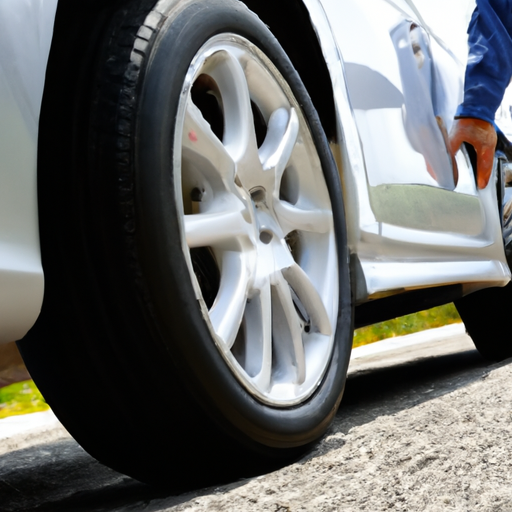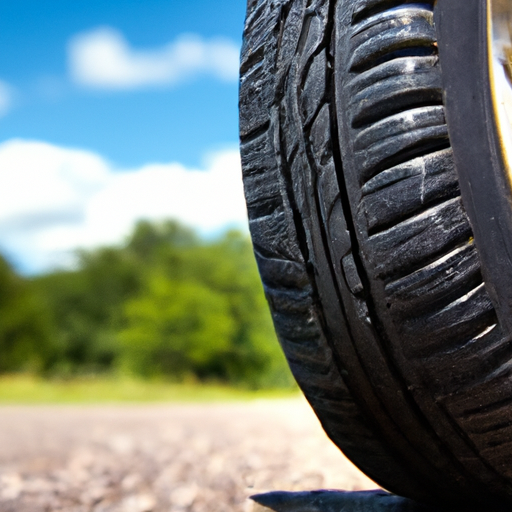When it comes to driving during the summer, one important factor to consider is the type of tires you have on your vehicle. Summer tires, also known as performance tires, are specifically designed for warmer weather conditions. They offer exceptional grip and handling on dry roads, making them a popular choice for many drivers. However, it’s crucial to understand the safety considerations associated with using summer tires to ensure a smooth and secure driving experience. Whether it’s the reduced traction on wet surfaces or the need for proper maintenance, this article will explore the specifics of using summer tires and highlight the necessary precautions to keep in mind.
Tire Composition
Rubber
The rubber used in the composition of tires plays a crucial role in determining the overall performance and safety of the tire. Summer tires are typically made of a special rubber compound that is optimized for warm weather conditions. This type of rubber is designed to provide excellent traction and grip on dry and hot surfaces, allowing for better control and handling. It is important to note that the rubber compound used in summer tires may harden in colder temperatures, which can significantly reduce their performance on wet or icy surfaces.
Tread Pattern
The tread pattern of a tire refers to the design of the grooves and sipes on the surface of the tire. In the case of summer tires, the tread pattern is specifically designed to enhance traction and grip on dry roads. The pattern typically features wider, shallower grooves that allow for maximum contact with the road surface, resulting in improved handling and cornering abilities. Additionally, the tread pattern helps to channel water away from the tire, reducing the risk of hydroplaning in wet conditions.
Sidewall Construction
The sidewall construction of a tire refers to the part of the tire that connects the tread area to the bead. This area is responsible for providing stability and strength to the tire. Summer tires often have sidewalls that are stiffer and more rigid compared to other types of tires. This increased rigidity helps to improve handling and responsiveness, allowing for precise steering and better overall control of the vehicle. Additionally, the sidewall construction can also have an impact on the ride comfort and noise level of the tire.
Tire Tread Depth
Minimum Tread Depth
The tread depth of a tire refers to the measurement of the depth of the tire’s grooves from the top of the tread to the bottom of the grooves. It is an important factor to consider when evaluating the safety and performance of a tire. In the case of summer tires, it is recommended to have a minimum tread depth of at least 4/32 of an inch. Tires with a lower tread depth may experience reduced traction and grip, especially on wet surfaces. It is crucial to regularly check the tread depth of your summer tires and replace them when they reach the minimum requirement to maintain optimal performance.
Relevant Tread Depth Indicators
It is not always easy to determine the exact tread depth of a tire with the naked eye. To help vehicle owners assess the condition of their summer tires, some manufacturers have incorporated tread depth indicators into their tire designs. These indicators appear as small bars or dots within the tire’s tread grooves. As the tread wears down, these indicators become more visible, providing a visual cue for when it is time to replace the tire.
Effect of Tread Depth on Performance
The tread depth of a tire directly affects its performance in various road conditions. Adequate tread depth is essential for maintaining traction and grip, especially on wet or slippery surfaces. As the tread wears down, the tire’s ability to channel water away from the contact patch diminishes, increasing the risk of hydroplaning. Additionally, worn-out tread can also reduce the tire’s ability to handle corners and perform well in emergency braking situations. It is crucial to monitor the tread depth of your summer tires regularly and replace them when necessary to ensure optimal safety and performance.

Temperature Range
Optimal Summer Tire Temperature
Summer tires are specifically designed to perform optimally in warm weather conditions. The optimal temperature range for these tires is typically between 40°F (4°C) and 90°F (32°C). At temperatures within this range, the rubber compound of the tire remains pliable, providing excellent traction and grip. Performance in this temperature range ensures better control, improved handling, and shorter braking distances, ultimately enhancing overall safety.
Tire Performance in Extreme Heat
While summer tires excel in warm weather, they may face challenges in extremely high temperatures. In scorching heat, the rubber compound can become too soft, leading to increased rolling resistance, reduced fuel efficiency, and accelerated tread wear. Moreover, excessively hot road surfaces can further contribute to the heat buildup in the tire, potentially causing blowouts or tread separation. It is important to monitor tire pressure and avoid overloading the vehicle during extreme heat to mitigate these risks.
Tire Performance in Cold Weather
Summer tires are not suitable for cold weather conditions, as the rubber compound tends to harden in low temperatures. This hardening can significantly diminish traction and grip on snow, ice, and even wet surfaces. In cold weather, summer tires may lose their flexibility, making them less effective in providing the necessary grip for safe driving. It is highly recommended to switch to winter or all-season tires when temperatures consistently drop below 40°F (4°C) to ensure optimal safety on the road.
Hydroplaning Resistance
Groove Design
The design of the grooves on a tire plays a crucial role in its ability to resist hydroplaning. Summer tires are equipped with a fine balance of wide and narrow grooves that work together to maintain proper contact with the road surface in wet conditions. The wider grooves help to channel water away from the tire, while the narrower grooves enhance surface grip. This effective groove design increases the tire’s ability to resist hydroplaning and ensures better stability and control when driving through wet roads.
Water Evacuation Channels
In addition to the groove design, summer tires often incorporate specialized water evacuation channels. These channels further aid in expelling water from the contact patch, enhancing the tire’s performance in wet conditions. By directing water away from the areas in contact with the road, these channels help to maintain optimal traction and reduce the risk of hydroplaning.
Effect of Speed on Hydroplaning
The risk of hydroplaning is not solely dependent on tire design; speed also plays a significant role. As the speed of the vehicle increases, the amount of water the tires encounter also increases. This increase in water volume makes the tire more prone to hydroplaning. It is important to adjust your driving speed to the prevailing road conditions, especially during heavy rain or when there is standing water on the road. Slowing down can greatly reduce the risk of hydroplaning and enhance overall safety.

Dry vs Wet Performance
Tire Compound
The rubber compound used in the construction of summer tires is specifically formulated to provide optimal performance on dry roads. This compound is engineered to deliver excellent traction, grip, and responsiveness, allowing for precise control and handling. However, it is important to note that the same rubber compound may not perform as effectively on wet surfaces. The harder nature of summer tires’ rubber compound in cold or wet conditions can result in reduced traction and increased braking distances.
Contact Patch
The contact patch refers to the area of the tire that is in direct contact with the road surface. Summer tires are designed to maximize the contact patch on dry roads, optimizing grip and handling. The wider and flatter profile of summer tires ensures a larger contact surface, thereby enhancing traction and improving braking and cornering performance. However, when it comes to wet performance, the same wide contact patch can lead to a higher risk of hydroplaning, as water may not be effectively channeled away from the tire.
Braking and Cornering
Summer tires excel in dry conditions, providing superior braking and cornering capabilities. On dry roads, the specialized rubber compound and tread design of summer tires work together to deliver enhanced grip and traction. This enables shorter braking distances and improved stability when navigating corners or turns. However, it is essential to exercise caution when driving on wet surfaces, as the performance of summer tires may be compromised, leading to longer braking distances and reduced control.
Road Noise
Tire Design
Road noise refers to the sound generated by the interaction between the tires and the road surface. The design of the tire, including the tread pattern, sidewall construction, and overall structure, can all contribute to the level of road noise produced. Summer tires are generally designed with a focus on performance, which can result in slightly louder road noise compared to other types of tires. However, advancements in tire technology have allowed manufacturers to develop quieter summer tires that provide a good balance between performance and driving comfort.
Tire Pressure
Properly inflated tires play a significant role in reducing road noise. It is important to maintain the recommended tire pressure specified by the vehicle manufacturer for optimal performance and driving comfort. Underinflated or overinflated tires can cause uneven wear, leading to increased road noise. Regularly checking and maintaining the correct tire pressure not only enhances the lifespan of your summer tires but also ensures a quieter and more comfortable driving experience.
Driving Comfort
While performance is a key aspect of summer tires, driving comfort should not be overlooked. The combination of tire design, tread pattern, and sidewall construction influences the overall comfort level experienced by the driver and passengers. Summer tires often provide a firmer and more responsive ride, which can be perceived as slightly harsher compared to tires designed for comfort. However, advancements in tire technology have allowed manufacturers to strike a balance between performance and driving comfort, ensuring an enjoyable driving experience with summer tires.

Tire Pressure Monitoring
Importance of Proper Tire Pressure
Proper tire pressure is crucial for maintaining the safety and performance of your summer tires. Underinflated tires can lead to reduced fuel efficiency, uneven tread wear, and decreased handling ability. Overinflated tires, on the other hand, can result in a harsher ride, decreased contact patch, and increased risk of blowouts. It is essential to regularly check and adjust the tire pressure according to the vehicle manufacturer’s recommendations to ensure optimal safety, performance, and longevity of your summer tires.
Tire Pressure Monitoring Systems
To make it easier for drivers to monitor tire pressure, many modern vehicles are equipped with Tire Pressure Monitoring Systems (TPMS). These systems use sensors to monitor and alert the driver when the tire pressure drops below or exceeds the recommended range. TPMS provides a convenient way to stay informed about the tire pressure status and helps to ensure that the tires are properly inflated, minimizing the risk of tire-related accidents and optimizing overall safety.
Effects of Underinflation and Overinflation
Underinflated summer tires can have several negative effects on performance and safety. The lack of proper air pressure reduces the tire’s ability to maintain optimal contact with the road, leading to reduced traction, increased rolling resistance, and longer braking distances. Underinflation also causes excessive heat buildup in the tire, increasing the risk of tire failure. On the other hand, overinflated tires have a smaller contact patch, diminishing grip and stability, resulting in a harsher ride and increased risk of tire damage. It is essential to regularly check and maintain the correct tire pressure to ensure safe and optimal performance.
Tire Rotation
Frequency of Rotation
Tire rotation is an important maintenance practice that helps prolong the lifespan and maintain the performance of your summer tires. It involves swapping the position of the tires on your vehicle to ensure even tread wear. The frequency of tire rotation depends on various factors, such as the type of vehicle, driving conditions, and tire wear characteristics. As a general guideline, it is recommended to rotate your summer tires every 5,000 to 8,000 miles or as specified by the vehicle manufacturer. Regular tire rotation promotes even wear, enhances traction, and extends the overall lifespan of your tires.
Tire Positioning
When rotating summer tires, it is important to follow the recommended tire positioning pattern provided by the vehicle manufacturer. The most common rotation patterns include the rearward cross, forward cross, and X-pattern rotations. These patterns ensure that each tire has an opportunity to perform in different positions, distributing the wear more evenly and optimizing performance. Proper tire positioning during rotation contributes to improved handling, consistent performance, and increased safety on the road.
Benefits of Regular Rotation
Regular tire rotation offers several benefits for summer tires. By spreading out the wear evenly, tire rotation helps to prolong the overall lifespan of the tires, maximizing your investment. Balanced tread wear also contributes to enhanced traction, improved handling, and better fuel efficiency. Additionally, regular rotation can identify potential alignment or suspension issues, allowing for timely adjustments and preventing further damage to the tires. Overall, adopting a proactive approach to tire rotation ensures optimal safety, performance, and cost-effectiveness.

Load Capacity
Maximum Load Rating
Every tire has a maximum load rating, which indicates the maximum weight capacity that the tire can safely support. It is important to match the load capacity of your summer tires with the weight requirements of your vehicle and the anticipated load. Using tires with a load rating that is lower than what is necessary can result in compromised handling, increased risk of tire failure, and reduced vehicle stability. It is crucial to check the maximum load rating of your summer tires and ensure that it is appropriate for your vehicle’s specific requirements.
Overloading Risks
Overloading a vehicle beyond its weight capacity can have severe consequences on tire performance and overall safety. Excessive weight puts added stress on the tires, causing them to heat up and potentially exceed their load rating. Overloaded summer tires may experience accelerated tread wear, increased rolling resistance, decreased traction, and reduced braking abilities. It is essential to adhere to the specified vehicle weight limits and avoid overloading your vehicle to ensure optimal tire performance, handling, and safety.
Effects on Vehicle Stability
The load capacity of summer tires directly affects the stability and handling of your vehicle. When the weight exceeds the recommended capacity, the tires may become overwhelmed, leading to increased sidewall flexing and decreased responsiveness. This can result in compromised stability, reduced control, and an increased risk of accidents. It is vital to match the load capacity of your summer tires to the weight requirements of your vehicle to maintain optimal stability and ensure safer driving experiences.
Tire Age and Inspection
Determining Tire Age
Tire age is an important consideration for both safety and performance. Even if the tread depth appears to be sufficient, the age of the tire can impact its overall condition. The manufacturing date of a tire is typically indicated by a four-digit number on the sidewall, representing the week and year of production. As a general guideline, it is recommended to replace tires that are over six years old, regardless of their tread depth. Tire aging can result in reduced flexibility, increased risk of blowouts, and compromised performance, making it crucial to inspect and replace aging summer tires.
Physical Inspection
Regular physical inspections of your summer tires are instrumental in identifying signs of wear and deterioration. It is essential to check for any cuts, bulges, cracks, or other visible damage on the tire’s sidewall or tread surface. Irregular tread wear patterns, such as excessive wear on one side or the center, may also indicate alignment or suspension issues. Additionally, inspecting the tire valves for leaks and ensuring proper valve cap installation is important for maintaining optimal tire performance. Regular physical inspections allow you to address potential issues promptly and ensure the safety and longevity of your summer tires.
Signs of Wear and Deterioration
There are several signs that indicate wear and deterioration in summer tires. One of the most common indicators is the tread wear indicators, also known as wear bars or tread wear indicators, which become visible as the tread depth reduces. Additionally, smooth or bald patches on the tire indicate excessive wear and reduced traction. Cracking or bulging on the sidewalls can be signs of aging or damage, requiring immediate attention. It is important to be vigilant and regularly inspect your summer tires for these signs of wear and deterioration, ensuring that they are replaced as needed to maintain optimal performance and safety on the road.
In conclusion, using summer tires requires specific safety considerations to ensure optimal performance and safety. Understanding the tire composition, tread depth, temperature range, hydroplaning resistance, dry vs. wet performance, road noise, tire pressure monitoring, tire rotation, load capacity, tire age and inspection are essential aspects to consider. By following these guidelines and regularly maintaining your summer tires, you can enjoy a safe and comfortable driving experience throughout the warm weather months. Remember, your tires are the only point of contact between your vehicle and the road, making their condition a top priority for safe and enjoyable journeys.


